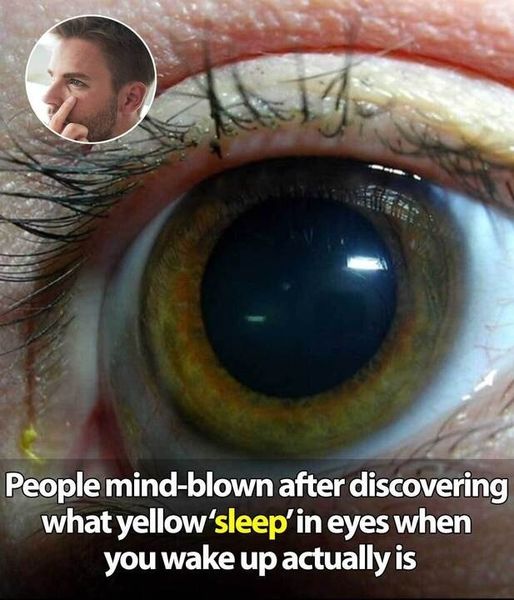We’ve all experienced waking up with sleep crust in our eyes at some point. You know the stuff: The yellow-ish, crusty stuff in the corners of your eyes when you wake up. We might not have given it much thought when we rub our eyes and see those white or yellowish sticky substances. However, this eye gunk, commonly known as sleep crust or ‘sleep’, actually holds interesting insights into our eye health. This is what sleep crust is, how it forms, and its implications for our eye health.
What is Sleep Crust?
It turns out that while we sleep, our eyes are fighting a battle. That’s right: A battle against bacteria and other unwanted, microscopic stuff. The crust in our eyes is the result of our eyes winning that battle. So, you could say that the yellow crusty stuff is kind of like a trophy of a battle fought and won while you slept. But what is this eye gunk really made of, and why is it yellow?
Sleep crust, known medically as “rheum,” refers to the combination of mucus, oil, skin cells, and debris that accumulate in the corners of our eyes during sleep. Despite its less glamorous appearance, sleep crust serves an essential purpose in our body’s natural self-regulating cleaning system. (1, 2)
The Process Behind Sleep Crust Formation
During the day, whenever we blink, our eyelids effectively remove dust, old cells, excess mucus, and tears from our eyes. However, when we are asleep, our blinking frequency significantly decreases, but the waste products in our eyes continue to be washed out.
The accumulation of sleep crust occurs when there is an excess amount of these waste materials, leading to a crusty film forming on the corner of our eyelids. It is worth noting that individuals with allergies may experience more eye crust during specific times of the year. This falls within the natural causes of sleep crust.
When Sleep Crust Indicates a Problem
While sleep crust is generally harmless and part of our body’s self-cleaning process, there are instances where it could signify an underlying problem. If you consistently experience excessive sleep crust or notice any unusual symptoms, it may be a sign to consult a healthcare professional.
1. Blepharitis
One condition that can cause extra crusty discharge from the eyes during the night is blepharitis. This condition refers to eyelid inflammation, which can result in redness, irritation, itching, foamy tears, and sensitivity to light. Blepharitis typically affects both eyes simultaneously and may require medical intervention.
2. Conjunctivitis
Conjunctivitis, commonly known as pink eye, is a condition involving inflammation of the thin membrane (conjunctiva) that lines part of the eye. It can be caused by various factors, including bacterial or viral infections, allergies, or environmental irritants. Symptoms of conjunctivitis include eye redness, watery discharge, and an accumulation of crust in the corner of the eye.
3. Eye Stye
An eye stye is an infection that causes a pustule to form on the upper or lower eyelid. It arises from infected or inflamed oil glands or follicles. If you have a stye, you may experience pain and a buildup of yellow mucus in the corners of the eye. Unlike other causes of sleep crust, a stye typically affects one eye only.
4. Blocked Tear Duct
A blocked tear duct can hinder the normal drainage of tears from the eyes. This condition may cause the accumulation of yellow or white mucus around the corner of one eye. Other symptoms may include redness, irritation, pain, and swelling of the eyelid.
5. Dry Eye
Chronic or occasional dry eye can result in the production of stringy mucus, leading to the accumulation of gritty or sticky sleep crust. Dry eye is a condition where the eye does not produce enough tears or maintains an inadequate tear film to lubricate and nourish the eye’s surface.
When to Seek Medical Help
While mild cases of sleep crust can be managed at home, certain signs and symptoms indicate the need for professional medical assistance. You should see an eye doctor if you experience any of the following:
- Severe eye pain
- Intense redness and irritation
- Difficulty opening your eyes due to excessive gunk or other issues
- Green or dark yellow eye discharge
- Light sensitivity
- Blurred vision
An eye doctor can conduct a comprehensive examination to determine the cause of your symptoms. Treatment may involve prescription eye drops or antibiotics if there is an infection or inflammation present. Blepharitis, conjunctivitis, or chronic dry eye conditions may require specific treatment methods.
Taking Care of Your Eyelids
To reduce the occurrence of sleep crust and promote overall eye health, it is crucial to maintain good eyelid hygiene. Here are some simple tips to incorporate into your daily routine:
- Wash your face before bed and gently cleanse your eye area using a clean, cool washcloth (avoid using soap or cleanser near the eyes).
- Thoroughly remove eye makeup before sleeping, using an eye makeup remover, cotton pad, or makeup removal wipe.
- Minimize touching and rubbing your eyes throughout the day, and remember to wash your hands if you do.
- Remove contact lenses before lying down and follow the recommended usage guidelines provided by the manufacturer.
The Bottom Line
Waking up with sleep crust is a common occurrence that typically indicates our eyes are performing their natural cleaning ritual. However, excessive or abnormal sleep crust, along with other symptoms, may indicate an underlying issue that warrants medical attention. By understanding the causes and potential implications of sleep crust, along with practicing good eyelid hygiene, we can ensure the health and well-being of our eyes. Remember, when in doubt, seeking professional advice is always beneficial for maintaining optimal eye health.




